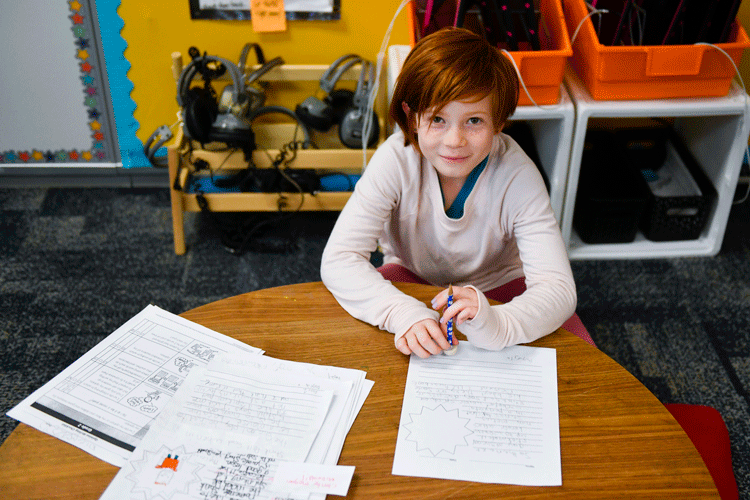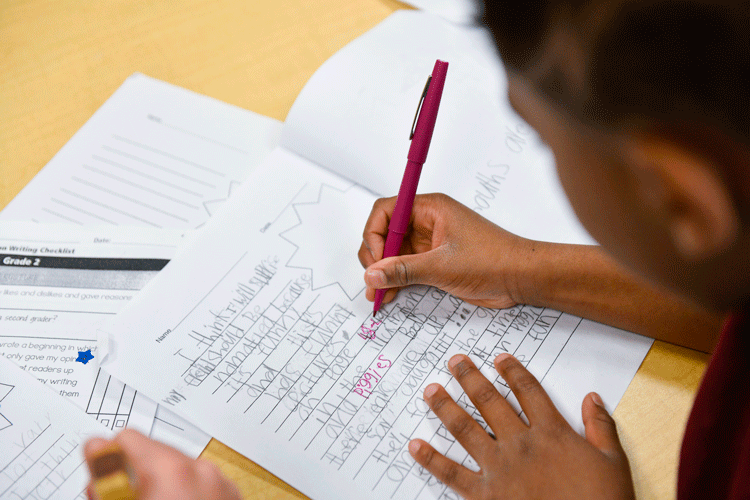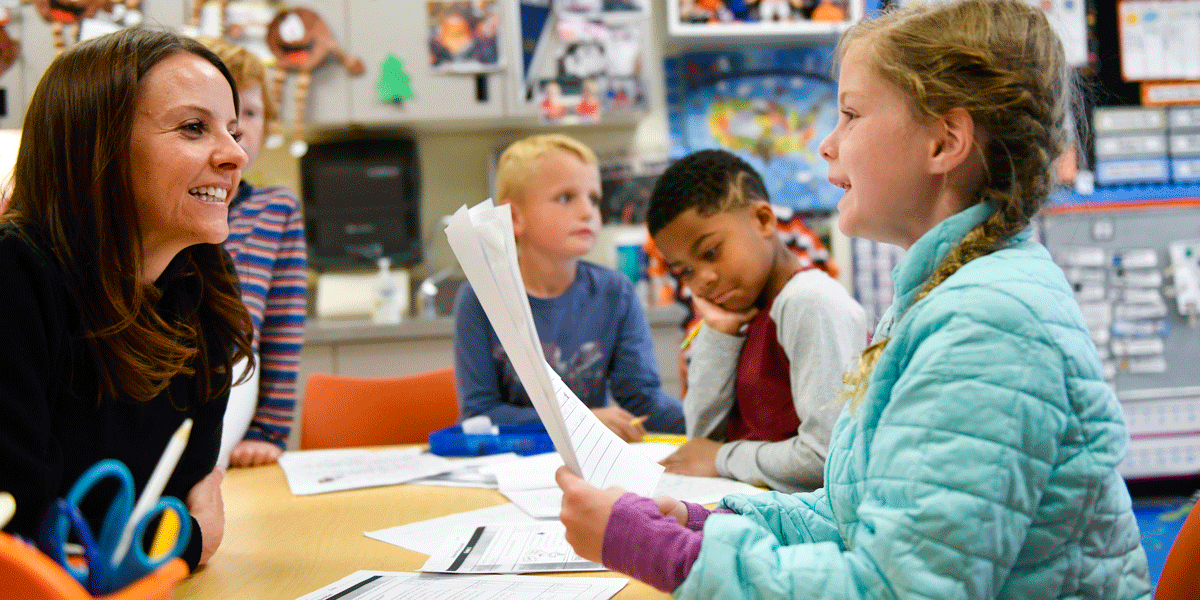When Andrew Esposito began working on a personal narrative in Jessica Ohly’s Fifth Grade Writer’s Workshop at Colorado Academy, his first effort was titled “My Small Incident.” Here’s a short excerpt from his story about a wheelie gone wrong.
I was biking. I like biking. I also like popping wheelies, so that’s what I did. I’d been practicing my wheelies for a month now, and I thought I was pretty good. So there I was, popping my wheelies. Then I tried to take it to the next level (emphasis on ‘tried’).
Within the next few weeks in Writer’s Workshop, it was Andrew’s writing that moved to the next level, developing in ways that would be obvious to even a casual reader—he painted scenes with words, he tried new techniques, he experimented with dialogue, and his language and sentence structure evolved in complexity. Take a look at an excerpt from his final piece in the unit, “The Bad Valve.”
I’m in the zone, playing well and focused on nothing else. I hit the E nice and strong, slamming down on the first and second valves, immediately moving on to the next note, a B, but it turns into a weird A because the first valve is sticking.
“How am I supposed to practice like this?” I ask my trumpet as I watch the first valve rising slowly….
Now I’m worried because my grandma and grandpa are coming and my grandpa also plays trumpet. Also, guess why they are coming? My first trumpet recital. So yeah, pressure’s on…..
I say a little prayer to whatever almighty force might be out there in the hopes that when I get home, my trumpet will be fixed and run out the door.
The evolution of Andrew’s writing didn’t happen by accident. It was part of the systematic program of writing used in the Lower School, the Lucy Calkins Units of Study for Teaching Writing, developed at the Teachers College at Columbia University. The method has sparked great enthusiasm from Colorado Academy Lower School teachers, many of whom have received special training in this curriculum.

“Every student can be successful with this approach, and as a result they blossom,” says Second Grade teacher Jessica McCoy. “When I tell them that writing is on our schedule for the day, they all cheer.”
“I was blown away at the beginning of the year, because students start the year knowing how to write,” says Third Grade teacher Stephanie Stone. “The methods, the language teachers are using is the same each year, so you don’t have to spend time reinventing the process.”
“Students are naturally writers,” says Ohly, who first learned about the Lucy Calkins method in graduate school. “This methodology makes them very independent. They are not waiting for a teacher to give them a prompt. They learn that writers are their own job captains.”

How the Lucy Calkins method works
The Calkins method identifies a variety of types of writing that all Lower School students, starting in Kindergarten, can do: personal narrative, information/expository, persuasive, essays, poetry, and fiction, among others.
Each day, a teacher presents a mini-lesson introducing a singular writing skill, a teaching point, or a strategy students can use in their writing that day, every day, and every year. The lessons are wide-ranging—anything from punctuation or ways to look for evidence in a text to support an opinion. Students take the lessons and move straight to independent practice with guidance from their teacher, writing for as long as an hour every day. Some students will take the new lesson and challenge themselves during the writing session. Other students will be practicing previously taught skills.
“This is independent practice where they work out an individualized plan for their own writing,” McCoy says. “They can work on their own terms.”
At the end of their writing time, students gather to share and offer peer reviews of each other’s work, often working with writing partners.
“It’s an approach that is very not teacher-centered,” Ohly says. “You start off assuming they will forget the teaching points, and then you come across a student who is using a new technique days later, because it stuck with them, and they are integrating it into their writing.”
To say that the Calkins method is not teacher-centered should not imply that teachers are not involved. Watching Ohly in action with her students, you will see her enthusiasm for teaching writing.
“Writers!” she addresses her students. “Let’s talk about a “Story Mountain!” (That’s the classic rising and falling action in every story, a concept as old as Aristotle.) “Writers of narrative fiction make a plan using the Story Mountain. Writers, what are the challenges in your story? What is the climax? The backstory? If you are not excited about your first plan, make another plan before your first draft!”
In response, there is noisy chatter in the room as writing partners bounce Story Mountain ideas off each other.
Go up the hall to McCoy’s room, and students are writing book reviews. This is not the traditional “book report” many might remember from their elementary school days.
“For Second Grade, a book review is sophisticated,” McCoy says. “They are reviewing books to persuade people to read them, so we teach them how to look for evidence in the text to support an opinion.”
McCoy’s students are particularly proud—and motivated to edit carefully—because their writing is published and stocked in the CA Lower School Library, complete with bar code for checkout.
“I always say, ‘Real writers are never done,’” McCoy says. “Even published writers know they should look at their book and see where there could be revisions. Writing is an ongoing process.”

How the Lucy Calkins method has changed writing in Lower School
Many adults will remember discovering a love or distaste for writing in elementary school, often with assignments that started with a worksheet or a picture and a prompt: “What did you do over summer vacation?” “What do you like to do during recess?”
Thinking back 11 years, Stephanie Stone can remember how teachers approached writing when she started at CA.
“We had a general outline about what students should learn in a year,” she says. “But teachers could follow their own passions, and there was a great deal of flexibility.”
Now with a consistent curriculum that spans six years, young CA writers can grow, and teachers can maximize results of their efforts. In much the same way that students come into a grade with defined math skills that they have learned in the previous year, they now come in with writing skills and expectations about how Writer’s Workshop works.
“This reduces the anxiety around writing,” Stone says. “Students do peer review, and after reading each other’s writing, they are inspired to make their writing better. They no longer ask me, ‘Is this good?’ They know their revisions have made their writing better, and that is wonderful.”
Try to interview the students during Writer’s Workshop, and you have a sense you are interrupting some fast-flowing creative juices. In Ohly’s class, Claire Prior is working on a story about a world where the color of someone’s eyes determines what they will do for their entire life. Her main character, Aspen, has deep indigo eyes and does not want to follow the rules that have been predetermined for her. “I really like writing fiction,” Claire says. “I like to be able to create what’s going to happen.”
And at another desk, Andrew Esposito is working on his next piece. “Miss Ohly gives us teaching points and those really help,” he says. “I start writing, I critique myself, that gets me into the flow. I just tweaked this story and changed the moral I had in mind. I followed a plan, and that made it better.”
